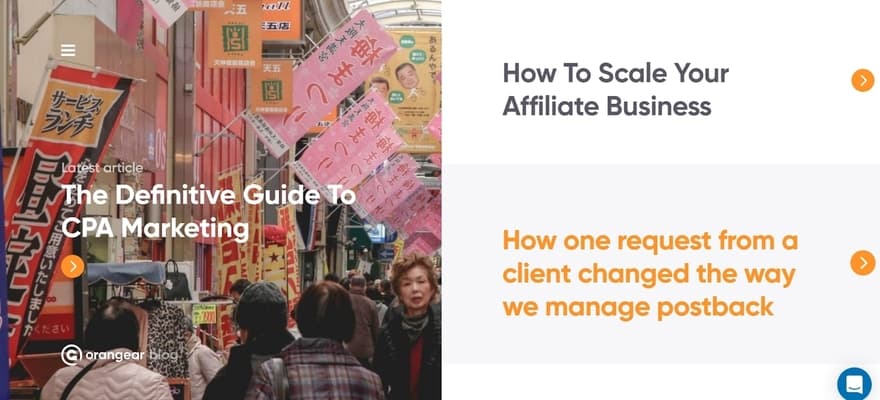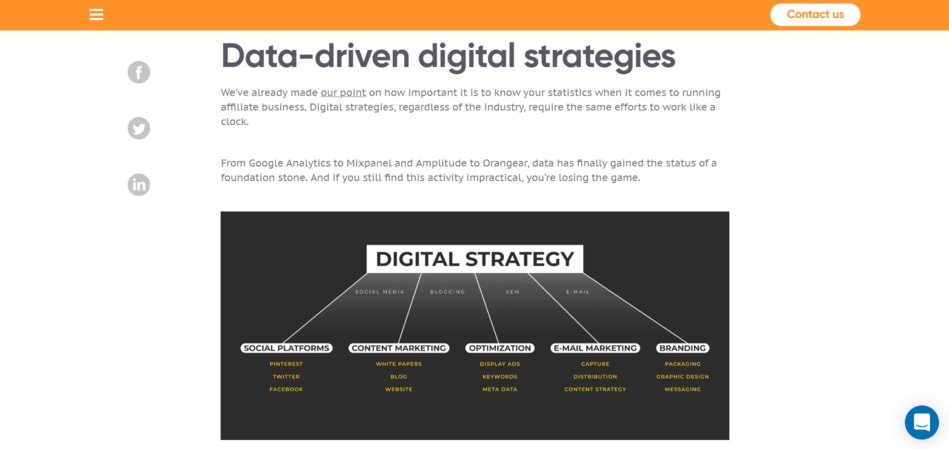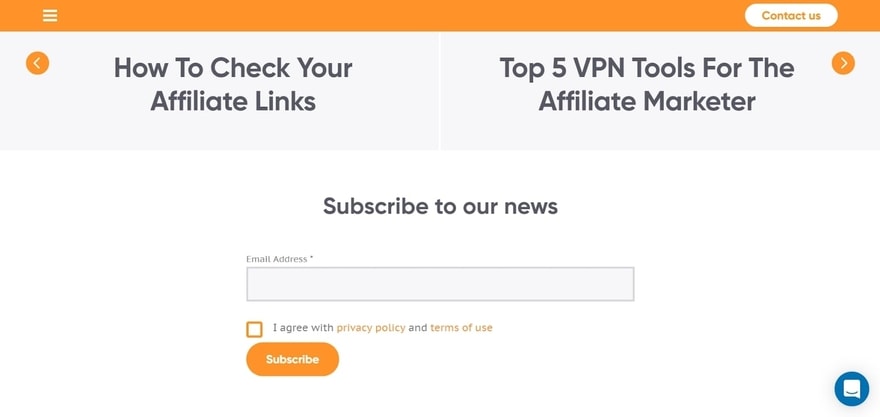Content-marketing has finally gained its well-deserved place on a shelf of business essentials.
Following the trend, many companies feel the need to create corporate blogs, sharing their opinions and promoting brands. That said, many bloggers and editors forget about the ultimate goal of every article -- to attract new customers. It’s time to put a stop to this tendency.
Here are the five steps that will help you get your content on the track of lead generation.
Following the trend, many companies feel the need to create corporate blogs, sharing their opinions and promoting brands. That said, many bloggers and editors forget about the ultimate goal of every article -- to attract new customers. It’s time to put a stop to this tendency.
Here are the five steps that will help you get your content on the track of lead generation.
Step 1: Know your audience
Getting acquainted with the target audience is the first step of any marketing strategy. And yet, many blog authors forget about the basics in favor of writing about what they find interesting. As a result, they end up with irrelevant content, wondering why it doesn’t convert the way they want it to.
What’s the point of spending time creating amazing content if your readers show no interest in the topics you cover? So before you start writing, find out what your audience is looking for.
What’s the point of spending time creating amazing content if your readers show no interest in the topics you cover? So before you start writing, find out what your audience is looking for.
Ask questions
One of the best ways to do that is to create a poll: newsletter or messenger, choose an appropriate tool. Divide your audience into segments and poll them separately to get even more precise data.Research reactions
Chances are, you already have a couple of accounts with some followers. Now it’s time to analyze your activity and the feedback it gets. Make sure to revisit topics that elicit more reaction (likes, shares, comments).Analyze behavior
If you want a more in-depth insight into your audience’s behavior, use Google Analytics. The tool shows how blog visitors interact with your content, what time they spend reading and what topics make them leave. GA is a necessity for every online business, but it’s ok if you don’t want to deal with it — just hire a digital marketing specialist.Step 2. Solve a problem
Steve Jobs once said: “Get closer than ever to your customers. So close that you tell them what they need well before they realize it themselves”.
The way I understand it is that at first, you have to know your customers, down to what kind of tea they prefer, what dreams they nourish. Then you get to tell them what they need.
It works just the same with blogging. Learn as much as you can about your readers and what’s important to them to create content accordingly. For every article you write, make its usefulness your priority.
What do your readers search for on the web? Come up with relevant answers to draw their undivided attention. You can go as far as naming your article in the form of an answer. Of course, this method works even better when you have actual questions from your readers. Don’t just turn them into a boring FAQ. Make it count.
The way I understand it is that at first, you have to know your customers, down to what kind of tea they prefer, what dreams they nourish. Then you get to tell them what they need.
It works just the same with blogging. Learn as much as you can about your readers and what’s important to them to create content accordingly. For every article you write, make its usefulness your priority.
What do your readers search for on the web? Come up with relevant answers to draw their undivided attention. You can go as far as naming your article in the form of an answer. Of course, this method works even better when you have actual questions from your readers. Don’t just turn them into a boring FAQ. Make it count.

Step 3. Polish the quality
Every post on a corporate blog is a part of the branding strategy. The quality of the content you present will determine future conversions. So if your writing is boring, it’s not just the audience you lose. The web is too full of information, and the attention of your target audience is something you’ll have to fight for. No one is going to wait for that spectacular ending you had in mind when the rest of the text is mundane. It’s too easy to close the tab and move on.
Sometimes, even when you have something important to share, the lack of skill can become a burden. So it’s never too late to improve your copywriting talent. Thankfully, with the number of books, articles, and courses on the market, you can always choose the learning path that will suit your needs.
However, if you’re not into writing yourself, even if you have tons of great ideas, you can delegate to a professional copywriter. I always recommend hiring in-house specialists, as they are, usually, much more dedicated to the final results. Plus, once you set up all the processes, there will be no need to create specific technical tasks for each article.
Start with selecting a simple, readable font of a decent size. And forget about that fancy greyish text color. It’s difficult to read and is not very good for the eye-sight.
Next, divide your long read into small chunks with proper headings. It will help your audience both understand your logic and find their way back to certain points at any time.
It’s essential to remember that both the form and the meaning play important parts in determining your results. The text should be both interesting, helpful and readable to inspire your audience for actions like subscribing to your service or purchasing your product.
Improve your skills or hire a professional
Make every word count. Once you set the value as your #1 priority for every article, it’s going to be easier to stop yourself from posting dull texts.Sometimes, even when you have something important to share, the lack of skill can become a burden. So it’s never too late to improve your copywriting talent. Thankfully, with the number of books, articles, and courses on the market, you can always choose the learning path that will suit your needs.
However, if you’re not into writing yourself, even if you have tons of great ideas, you can delegate to a professional copywriter. I always recommend hiring in-house specialists, as they are, usually, much more dedicated to the final results. Plus, once you set up all the processes, there will be no need to create specific technical tasks for each article.
Pay attention to the form
It takes seven seconds to make the first conclusions about a new acquaintance. If you go for an interview, you have to look the part first, to get an opportunity to show your intellectual capabilities, etc. Why would it be much different with the content? So unless you’re writing a diary, make sure the form allows your audience to dive into the meaning with no obstacles.Start with selecting a simple, readable font of a decent size. And forget about that fancy greyish text color. It’s difficult to read and is not very good for the eye-sight.
Next, divide your long read into small chunks with proper headings. It will help your audience both understand your logic and find their way back to certain points at any time.
Add visuals
It’s no news that the world is getting more visual these days and the same goes for blogs. Plain text looks dull and more often than not you will find that it’s easier to express or stress particular thought with infographics, statistical or analytical charts, or even small videos and gifs.It’s essential to remember that both the form and the meaning play important parts in determining your results. The text should be both interesting, helpful and readable to inspire your audience for actions like subscribing to your service or purchasing your product.

Step 4. Inspire loyalty
Loyal readers are the most promising future customers. When people trust your opinion enough to come back to your articles time and time again, they are more likely to believe in your product as well.
Here are some ways to improve your audience’s loyalty:
Share relevant information. Time flies; everything changes. No one is going to be interested in your stats for 2009 (unless they’re conducting some research). Use the latest, trustworthy data to communicate your points.
Generate unique content. It’s easy to copy and paste, but the audience is always looking for unique gems. Original posts will help you get better user engagement levels and increase conversion into loyal readers.
Provide expert opinion. Invite industry specialist for interviews or simply add their quotes to support your thoughts.
Encourage communication. Talk to your audience, show them that their opinion is valued. Inspire new interactions by asking their opinion on the content you’ve shared.
Show yourself. Give your written voices human faces by sharing pictures of your team. If you think your business is boring, get help from copywriters to change that!
Here are some ways to improve your audience’s loyalty:
Share relevant information. Time flies; everything changes. No one is going to be interested in your stats for 2009 (unless they’re conducting some research). Use the latest, trustworthy data to communicate your points.
Generate unique content. It’s easy to copy and paste, but the audience is always looking for unique gems. Original posts will help you get better user engagement levels and increase conversion into loyal readers.
Provide expert opinion. Invite industry specialist for interviews or simply add their quotes to support your thoughts.
Encourage communication. Talk to your audience, show them that their opinion is valued. Inspire new interactions by asking their opinion on the content you’ve shared.
Show yourself. Give your written voices human faces by sharing pictures of your team. If you think your business is boring, get help from copywriters to change that!
Step 5. Turn readers into leads
One of the best ways to turn your readers into warm leads is email-marketing. Thankfully, it won’t cost you a fortune.
Popup. You can use PopupDomination service to add a popup window to your blog, asking your readers to subscribe. Expect around 1-3% conversion using this method.
Sidebar. Another decent position for a subscription form is a sidebar. You can get up to 2% CR like that.
The end of a post. Alternatively, you can ask your reader to subscribe at the end of every blog post. This option will also get you up to 2% CR.
Choose the placement that will fit your blog style and consider your readers’ experience. And don’t be discouraged by the seemingly low conversion rates!
You can also use some incentive to get their emails, offering free white papers, podcasts, or research results.
Whichever way you use, make sure you don’t overcomplicate the form. More fields result in less CR, so leave out all the additional ones, sticking to the essentials. The best form will have one area to fill in — email. Later on, when you prove that you’re not a spammer, the will be numerous opportunities to ask for any other info you’re curious about.
Gather emails
To start, you will need to gather emails, and there are a couple of ways to do that:Popup. You can use PopupDomination service to add a popup window to your blog, asking your readers to subscribe. Expect around 1-3% conversion using this method.
Sidebar. Another decent position for a subscription form is a sidebar. You can get up to 2% CR like that.
The end of a post. Alternatively, you can ask your reader to subscribe at the end of every blog post. This option will also get you up to 2% CR.
Choose the placement that will fit your blog style and consider your readers’ experience. And don’t be discouraged by the seemingly low conversion rates!
You can also use some incentive to get their emails, offering free white papers, podcasts, or research results.
Whichever way you use, make sure you don’t overcomplicate the form. More fields result in less CR, so leave out all the additional ones, sticking to the essentials. The best form will have one area to fill in — email. Later on, when you prove that you’re not a spammer, the will be numerous opportunities to ask for any other info you’re curious about.

Plan a campaign
As with the rest of the marketing activity, the success of your newsletters will depend on how good your plan is.If the ultimate goal is to sell a product, come up with a churn of letters that will help your prospective customer make a decision. Start with educational content, continue with information that will help you gain the trust of your readers, and finish off with a call-to-action letter. From our experience, it takes around seven letters to get a conversion, and the CR is about 5%. So if you have 500 subscribers, 50 of them can become your customers within the timeframe of your campaign.
Track and optimize
No matter how many materials you’ll read on the subject, mistakes can and will happen. Your audience is unique to you, and there’s no way to know for sure how they’ll react to your letters. Carefully test different things and determine what works best for you.Just like with any other marketing activity, you have to be mindful of what you do, and have a strategy on your hands. Otherwise, all your efforts will most likely go to waste.
To summarize, what you need to turn blog readers into customers:
The biggest advantages of business blogs is that they help you speak with your target audience, build a relationship with them but also drive qualified traffic, generate leads and improve your brand awareness, authority, trust and credibility.If I had to pick the best 4 tips to convert your blog readers into clients, those would be: ● research your audience;
● offers solutions to their problems;
● generate unique, intriguing, and useful content;
● use email-marketing to turn readers into leads and leads into customers.
It will take time and resources to start a decent blog, but it can become one of your top sources of warm leads.
What do you think? Is it worth it?
Growth Hackers is recognized as one of the best inbound marketing agencies, we use blogging for ourselves and also for our clients. We write long-form, interesting, engaging and compelling blog posts to build our brand as well as building the brands of our clients. We spend 20% of the time creating new blog posts and 80% of the time promoting and distributing the content. This is not it. We don't just want blog readers. We want these blog readers to become customers. This is where conversion rate optimization as well as creative copywriting become vital. At Growth Hackers, we go further than just driving traffic to blog posts. We generate leads and make sales thanks to a blog. If you want to start a blog or turn your blog readers into customers connect with GrowthHackers here and you'll get leads and sales from your blog in no time.





1 Comment
Great post I would like to thank you for the efforts to writing this interesting and knowledgeable article.
I really appreciate this post thank you for sharing these type of posts. (: